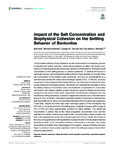Impact of the Salt Concentration and Biophysical Cohesion on the Settling Behavior of Bentonites
| dc.contributor.author | Krahl, E | |
| dc.contributor.author | Vowinckel, B | |
| dc.contributor.author | Ye, L | |
| dc.contributor.author | Hsu, T-J | |
| dc.contributor.author | Manning, Andrew | |
| dc.date.accessioned | 2022-08-25T09:46:25Z | |
| dc.date.available | 2022-08-25T09:46:25Z | |
| dc.date.issued | 2022-07-15 | |
| dc.identifier.issn | 2296-6463 | |
| dc.identifier.issn | 2296-6463 | |
| dc.identifier.other | 886006 | |
| dc.identifier.uri | http://hdl.handle.net/10026.1/19567 | |
| dc.description.abstract |
<jats:p>The flocculation behavior of clay minerals in aquatic environments is an important process in estuarine and riverine dynamics, where strong gradients in salinity can locally occur. Various contradicting observations have been reported in the literature on the impact of salt concentration on the settling process of cohesive sediments. To address this issue in a systematic manner, we investigate the settling behavior of clay minerals as a function of the salt concentration of the ambient water. Specifically, we focus on montmorillonite as a prototype clay mineral with a high cation exchange capacity (CEC). To this end, we study suspensions of Wyoming bentonite (Volclay SPV) as a very important constituent for many constructional and industrial purposes. We perform an experimental campaign to study the settling behavior of moderately turbid montmorillonite concentrations in monovalent salt solutions with different salinities (sodium chloride) to represent different environments ranging from deionized to ocean water, respectively. The subsequent settling process was monitored by taking pictures by a camera in regular time intervals over a total observation time up to 48 h. In addition, a modified hydrometer analysis is conducted to determine the grain size distribution (in terms of an equivalent diameter) of the flocculated clay suspension in salt water. Despite the rather high cation exchange capacity of the investigated clay (CEC=88.1), our results show that the settling speed drastically increases within a range of 0.6–1.0 PSU and stays approximately constant for higher salinities. This critical salt concentration is defined here as the critical coagulation concentration (CCC) and lies well below the salinity of natural open water bodies. The hydrometer analysis revealed that 60% of the agglomerates exceed the equivalent grain size of 20 μm. Finally, the findings of this study are supplemented with experiments studying the effect of Extracellular Polymeric Substances (EPS) on the flocculation behavior of bentonite in salt water. Our results demonstrate that salinity is the original trigger for flocculation, whereas EPS allows for even larger floc size but it does not play a significant role for the settling processes of bentonite in estuarine environments.</jats:p> | |
| dc.format.extent | 886006- | |
| dc.language.iso | en | |
| dc.publisher | Frontiers Media | |
| dc.subject | bentonite | |
| dc.subject | suspension | |
| dc.subject | settling | |
| dc.subject | flocculation | |
| dc.subject | critical coagulation concentration | |
| dc.subject | extracellular polymeric substances | |
| dc.title | Impact of the Salt Concentration and Biophysical Cohesion on the Settling Behavior of Bentonites | |
| dc.type | journal-article | |
| dc.type | Journal Article | |
| plymouth.author-url | https://www.webofscience.com/api/gateway?GWVersion=2&SrcApp=PARTNER_APP&SrcAuth=LinksAMR&KeyUT=WOS:000834248200001&DestLinkType=FullRecord&DestApp=ALL_WOS&UsrCustomerID=11bb513d99f797142bcfeffcc58ea008 | |
| plymouth.volume | 10 | |
| plymouth.publication-status | Published online | |
| plymouth.journal | Frontiers in Earth Science | |
| dc.identifier.doi | 10.3389/feart.2022.886006 | |
| plymouth.organisational-group | /Plymouth | |
| plymouth.organisational-group | /Plymouth/Faculty of Science and Engineering | |
| plymouth.organisational-group | /Plymouth/Faculty of Science and Engineering/School of Biological and Marine Sciences | |
| plymouth.organisational-group | /Plymouth/REF 2021 Researchers by UoA | |
| plymouth.organisational-group | /Plymouth/REF 2021 Researchers by UoA/UoA07 Earth Systems and Environmental Sciences | |
| plymouth.organisational-group | /Plymouth/Research Groups | |
| plymouth.organisational-group | /Plymouth/Research Groups/Marine Institute | |
| plymouth.organisational-group | /Plymouth/Users by role | |
| plymouth.organisational-group | /Plymouth/Users by role/Academics | |
| dcterms.dateAccepted | 2022-06-24 | |
| dc.rights.embargodate | 2022-8-26 | |
| dc.identifier.eissn | 2296-6463 | |
| dc.rights.embargoperiod | Not known | |
| rioxxterms.funder | Directorate for Geosciences | |
| rioxxterms.identifier.project | Collaborative Research: Understanding the physics of flocculation processes and cohesive sediment transport in bottom boundary layers through multi-scale modeling | |
| rioxxterms.versionofrecord | 10.3389/feart.2022.886006 | |
| rioxxterms.licenseref.uri | http://www.rioxx.net/licenses/all-rights-reserved | |
| rioxxterms.type | Journal Article/Review | |
| plymouth.funder | Collaborative Research: Understanding the physics of flocculation processes and cohesive sediment transport in bottom boundary layers through multi-scale modeling::Directorate for Geosciences |


